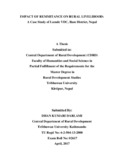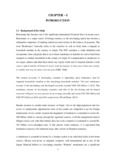Please use this identifier to cite or link to this item:
https://elibrary.tucl.edu.np/handle/123456789/2199| Title: | Impact of Remmitance on Rural Livelihood:A Case Study of Lumde VDC, Ilam District, Nepal |
| Authors: | Darlami, Dhan Kumari |
| Keywords: | Rural Livelihood |
| Issue Date: | 2017 |
| Publisher: | Central Department of Rural Development |
| Abstract: | Remittance economy is directly related to human resource and human resource is the wealth ofNation.This study is based on the Impact of Remittance in Rural Livelihood-A Case Study of Lumde VDCin Ilam District. The main objectives of the study are to analyze the situation inflows of remittance athousehold level, analyze the remittance use pattern in study area and to compare the socio economicstatus of the remittance recipients before and after receiving remittance. The researchwasconducted under ‘descriptive and explanatoryresearchdesign’. Itwas used to fulfillthe objectives of the study area. A total no. of households 122 among them there were 35 householdswere selectedforpurposive sampling.Bothprimaryandsecondary datawerecollected from differentsources.Primarydatawere collected through structured questionnairesurvey for before and afterreceiving remittancehousehold.While secondary datawere collected from,various publishedandunpublished information sources i.e. books, journals, annual reports and other official sources.Rremittance incomes werereceived from Malaysia, Saudi, United Arabs Emirates Dubai, Qatar, Omanand India. The share of remittance received from abroad is the highest from Malaysia and Saudi (30percent),Dubai and Qatar(14 percent) andother remaining countries hold only 2 percent theywereOman, Kuwait, Uk, Japan, India and USA. Most of the people entered the foreign countries throughagent(49 percent) which was highest due toinaccessibility to reach far away bigger cities but the agent were available excessively in the remotevillage . It was 20 percent through visa sent by relatives and direct contact with Manpower Companywas 31 percent.Among the foreign employment, about 51 percent (highest percentile) earn incomebetween the rangesofRs. 30000 to50000per months. Similarly, 29 percent earned income Rs.15000 to30000per month,11 percent employee earned income Rs .more than 50000per month,9 percentemployee earned less than 15000 per month, whichwas the lowest. Most of the remittance-receivinghousehold remitted from IME(International Money Express) which was 77.14 percent as this was the reliable means of sending and receiving money. The second popular means was finance and bank, whichcovers14.28 percent of total remit income. Finally, the last was Hundi it holds 8.57percent of totalincome.Respondents investtheir remitted money in shop with the percentof 14.28 and11.42percentwas utilized in dairy,Tailoring was of 8.57 percent in the same way, hotel occupy 14.28 percent,Teaindustry, cardamom and buying land carried 8.57, 28.57 and 14.28 respectively. Maximum amount ofremittancewasused in cardamom productionand earned good profit. Second most of remittanceamountwas invested in shop, hotel and buying land. Lastly, tailoring and tea industry figured out thelowest investment.Theremainedremittance were utilize for their basicneeds and daily needssuch as,food, clothes ,Transportation, medicine, education,Television ,mobile etc.Out of their total expenditureRS178,000 amount spending on furtherinvestment in economic activity which is the highest amount ofshare comparing with other expenditure of sample household. Before remittance number of boysstudent were 62.5 percent and girls were 37.5 percent. However, it was 61.90 percent for boys and38.09 percent for girls before and after remittance respectively. Number of girls’ students increasedafter remittance. Agricultural production before remittance was increase for 35.29 percent of respondents. It wasdecreasefor 23.52 percent and as usual for 41.17 percent. After remittance, the agricultural productionwas 22.22 percent increase, 27.77 percent decrease and 50 percent as usual. After remittance,agricultural production was lowest due to less availability of working age groups in the village.Surveyedhouses children's were attending boarding schools whereas before their parents were not engaged inforeign employment they were student of government schools. It is because of the negative thinkingtowards the teaching of government schools, the consciousness of their children’s education, andbecause of improved economic condition. |
| URI: | http://elibrary.tucl.edu.np/handle/123456789/2199 |
| Appears in Collections: | Rural Development |
Files in This Item:
| File | Description | Size | Format | |
|---|---|---|---|---|
| COVER.pdf | 72.5 kB | Adobe PDF |  View/Open | |
| CHAPTER.pdf | 280.84 kB | Adobe PDF |  View/Open |
Items in DSpace are protected by copyright, with all rights reserved, unless otherwise indicated.
